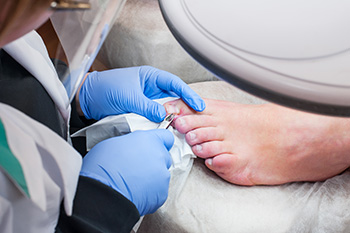

Falls are a leading concern for elderly individuals and are often linked to underlying health conditions that affect balance and stability. Poor vision from conditions like cataracts or macular degeneration can make it difficult to navigate safely, increasing the risk of tripping or misjudging steps. Diabetes can contribute to falls through nerve damage in the feet, known as peripheral neuropathy, which reduces sensation and affects coordination. Cardiovascular conditions, including irregular heart rhythms or low blood pressure, can cause dizziness or fainting episodes that lead to sudden falls. Other factors such as muscle weakness, joint pain, or medication side effects may also play a role. Falling can seriously impact the feet, possibly causing difficulty in maintaining independence. If you have injured your feet or ankles from falling or want your fall risk assessed, it is suggested that you consult a podiatrist.
Preventing falls among the elderly is very important. If you are older and have fallen or fear that you are prone to falling, consult with Dr. Larry Cohen from New York City. Our doctor will assess your condition and provide you with quality advice and care.
Every 11 seconds, an elderly American is being treated in an emergency room for a fall related injury. Falls are the leading cause of head and hip injuries for those 65 and older. Due to decreases in strength, balance, senses, and lack of awareness, elderly persons are very susceptible to falling. Thankfully, there are a number of things older persons can do to prevent falls.
How to Prevent Falls
Some effective methods that older persons can do to prevent falls include:
Falling can be a traumatic and embarrassing experience for elderly persons; this can make them less willing to leave the house, and less willing to talk to someone about their fears of falling. Doing such things, however, will increase the likelihood of tripping or losing one’s balance. Knowing the causes of falling and how to prevent them is the best way to mitigate the risk of serious injury.
If you have any questions, please feel free to contact our offices located in Midtown, Manhattan New York, NY . We offer the newest diagnostic and treatment technologies for all your foot care needs.

Webbed toes, also known as syndactyly, refer to a condition where two or more toes are fused together by skin, soft tissue, or, in rare cases, bone. This occurs during early fetal development when the toes fail to separate completely. Webbed toes are often inherited and may appear as an isolated trait or as part of a genetic syndrome. In most cases, the condition does not cause pain or interfere with walking, although it may be noticeable in appearance. Environmental factors during pregnancy, such as exposure to certain medications or substances, may also contribute to its development. Webbed toes can vary in severity and may be found in both feet or just one. While usually harmless, surgical correction is an option for individuals who desire a change in function or appearance. If you have been born with this condition and are experiencing discomfort, it is suggested that you are under the care of a podiatrist who can discuss relief options, including the possibility of surgery.
Congenital foot problems require immediate attention to avoid future complications. If you have any concerns, contact Dr. Larry Cohen of New York City. Our doctor can provide the care you need to keep you pain-free and on your feet.
Congenital foot problems are deformities affecting the feet, toes, and/or ankles that children are born with. Some of these conditions have a genetic cause while others just happen. Some specific foot ailments that children may be born with include clubfeet, polydactyly/macrodactyly, and cleft foot. There are several other foot anomalies that can occur congenitally. What all of these conditions have in common is that a child may experience difficulty walking or performing everyday activities, as well as trouble finding footwear that fits their foot deformity. Some of these conditions are more serious than others. Consulting with a podiatrist as early as possible will help in properly diagnosing a child’s foot condition while getting the necessary treatment underway.
What are Causes of Congenital Foot Problem?
A congenital foot problem is one that happens to a child at birth. These conditions can be caused by a genetic predisposition, developmental or positional abnormalities during gestation, or with no known cause.
What are Symptoms of Congenital Foot Problems?
Symptoms vary by the congenital condition. Symptoms may consist of the following:
Treatment and Prevention
While there is nothing one can do to prevent congenital foot problems, raising awareness and receiving neonatal screenings are important. Early detection by taking your child to a podiatrist leads to the best outcome possible.
If you have any questions please feel free to contact our offices located in Midtown, Manhattan New York, NY . We offer the newest diagnostic tools and technology to treat your foot and ankle needs.

When an ingrown toenail becomes painful, infected, or keeps coming back, a podiatrist may recommend surgery to fix the problem. One common procedure is a partial nail removal, where the podiatrist carefully removes the edge of the nail that is growing into the skin. To help prevent the nail from growing back in the same way, a chemical may be applied to the base of the nail to stop regrowth in that area. This often leads to long-term relief. In more severe cases, especially when the problem keeps returning or involves swelling at the base of the nail, the entire toenail may need to be removed. This procedure may be necessary when a new toenail begins to grow underneath an old one, instead of pushing it forward like it normally should. If you have an extremely stubborn or painful ingrown toenail, it is suggested that you make an appointment with a podiatrist for an exam, diagnosis, and treatment.
Ingrown toenails can become painful if they are not treated properly. For more information about ingrown toenails, contact Dr. Larry Cohen of New York City. Our doctor can provide the care you need to keep you pain-free and on your feet.
Ingrown Toenails
Ingrown toenails occur when a toenail grows sideways into the bed of the nail, causing pain, swelling, and possibly infection.
Causes
Prevention
Because ingrown toenails are not something found outside of shoe-wearing cultures, going barefoot as often as possible will decrease the likeliness of developing ingrown toenails. Wearing proper fitting shoes and using proper cutting techniques will also help decrease your risk of developing ingrown toenails.
Treatment
Ingrown toenails are a very treatable foot condition. In minor cases, soaking the affected area in salt or antibacterial soaps will not only help with the ingrown nail itself, but also help prevent any infections from occurring. In more severe cases, surgery is an option. In either case, speaking to your podiatrist about this condition will help you get a better understanding of specific treatment options that are right for you.
If you have any questions please feel free to contact our offices located in Midtown, Manhattan New York, NY . We offer the newest diagnostic and treatment technologies for all your foot and ankle needs.

Pregnancy brings many physical changes, and the feet are no exception. As the body adapts to support added weight and shifting posture, the arches may flatten, and swelling can increase. These changes can lead to foot pain, instability, and discomfort with everyday activities. Wearing supportive and properly fitting shoes during pregnancy is essential for maintaining balance and preventing strain on the feet, ankles, and lower back. Footwear with good arch support, cushioning, and a wide toe box can help accommodate changes in foot size and shape. Choosing the right shoes can also reduce the risk of falls and improve overall mobility. If you are pregnant and are experiencing foot pain, it is suggested that you visit a podiatrist who can guide you toward selecting supportive shoes that are right for you.
Pregnant women with swollen feet can be treated with a variety of different methods that are readily available. For more information about other cures for swollen feet during pregnancy, consult with Dr. Larry Cohen from New York City. Our doctor will attend to all of your foot and ankle needs.
What Foot Problems Can Arise During Pregnancy?
One problem that can occur is overpronation, which occurs when the arch of the foot flattens and tends to roll inward. This can cause pain and discomfort in your heels while you’re walking or even just standing up, trying to support your baby.
Another problem is edema, or swelling in the extremities. This often affects the feet during pregnancy but tends to occur in the later stages.
How Can I Keep My Feet Healthy During Pregnancy?
If you have any questions please feel free to contact our offices located in Midtown, Manhattan New York, NY . We offer the newest diagnostic and treatment technologies for all your foot and ankle needs.